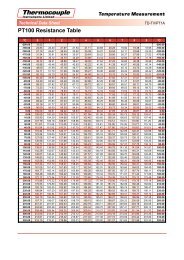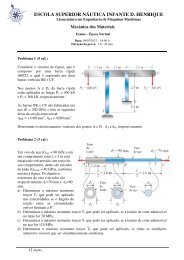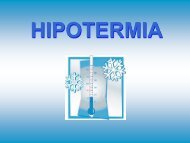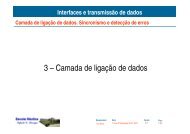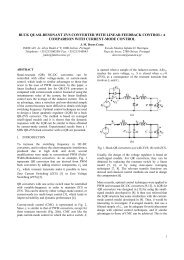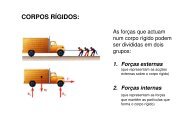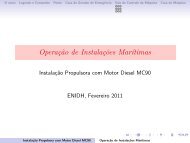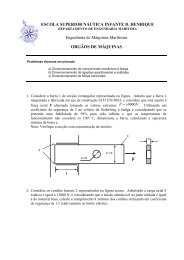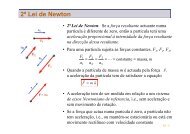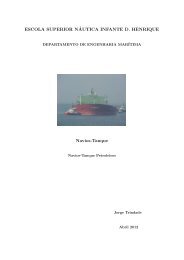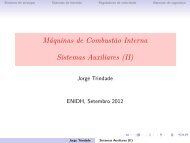Textos de Apoio (pdf)
Textos de Apoio (pdf)
Textos de Apoio (pdf)
Create successful ePaper yourself
Turn your PDF publications into a flip-book with our unique Google optimized e-Paper software.
ITTC – Recommen<strong>de</strong>d<br />
7.5-04<br />
-01-01.1<br />
Procedures and Gui<strong>de</strong>lines Page 5 of 10<br />
Full Scale Measurements<br />
Speed and Power Trials<br />
Preparation and Conduct of<br />
Speed/Power Trials<br />
Effective Date<br />
2005<br />
Revision<br />
03<br />
4.2 Ship Inspection<br />
There are three stages of a ship inspection:<br />
in-house preparation, the actual inspection, and<br />
the reporting of results and distribution of information<br />
to the various parties involved in the<br />
trial.<br />
4.2.1 Preparation for the trials<br />
• Review shafting dimensions, propulsion<br />
plant specifications, etc.<br />
• Review trials agenda, if available.<br />
4.2.2 Ship Inspection<br />
• Inspect hull- and propeller surface condition,<br />
if possible.<br />
• Inspect ship’s instrumentation for accessibility.<br />
• Determine routes for cable runs/data<br />
transfer conduits between trial room<br />
and bridge or control area.<br />
• Contact the Engineer on duty to discuss<br />
trial instrumentation requirements. Inspect<br />
machinery spaces as applicable.<br />
4.2.3 Reporting of Results and Distribution<br />
of Information<br />
Document all pertinent information related<br />
to the ship inspection<br />
a) Last date of cleaning.<br />
b) Means of cleaning.<br />
c) Propeller roughness measurement, if<br />
available, which should inclu<strong>de</strong> average,<br />
standard <strong>de</strong>viation, distribution<br />
along the bla<strong>de</strong>s, and existing physical<br />
damage.<br />
d) For a clean hull; documentation indicating<br />
manufacturer and kind of paint<br />
used, paint layer thickness and, if available,<br />
roughness measurements (average,<br />
standard <strong>de</strong>viation, and distribution<br />
along the hull) should be provi<strong>de</strong>d. The<br />
majority of this information may be<br />
contained in the docking report.<br />
e) For a dirty hull, documentation indicating<br />
visual observations of any fouling<br />
and date of last dry-docking should<br />
be provi<strong>de</strong>d.<br />
4.3 Hull- and Propulsor Survey<br />
A roughness survey is recommen<strong>de</strong>d to<br />
document the conditions of the ship hull, appendages,<br />
and propulsor(s) prior to the start of<br />
the full-scale speed/ power trial. Cleaning may<br />
be required if fouling is found to be such that it<br />
would bias the trial data.<br />
I<strong>de</strong>ally, roughness surveys should be conducted<br />
prior to the trials. The average hull<br />
roughness should not exceed 250 µm (µ =<br />
1x10 -6 m) (6.35 mils) and the average propulsor<br />
roughness level should not be greater than<br />
150 µm (3.81 mils).<br />
4.4 Instrumentation Installation and Calibration<br />
4.4.1 Instrumentation Installation<br />
The installation of instrumentation should<br />
be scheduled at a time of minimal conflict with<br />
ship operations.


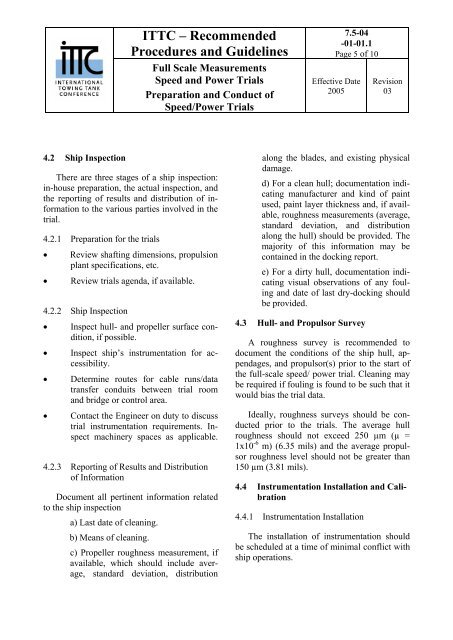
![Conceitos transmissao de dados .Sinais[.pdf]](https://img.yumpu.com/50982145/1/190x146/conceitos-transmissao-de-dados-sinaispdf.jpg?quality=85)
![Packages e interfaces[.pdf]](https://img.yumpu.com/50629553/1/190x134/packages-e-interfacespdf.jpg?quality=85)
